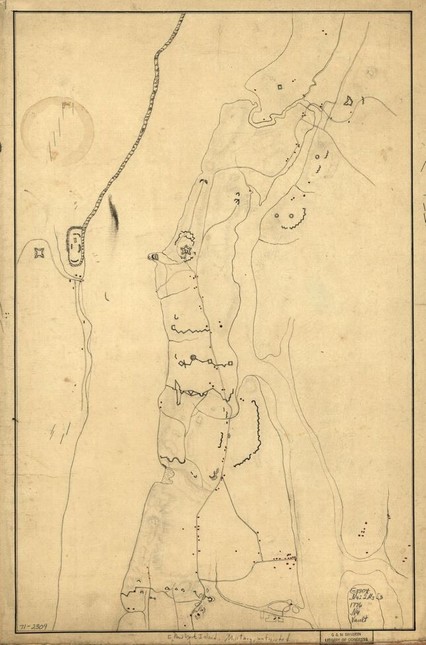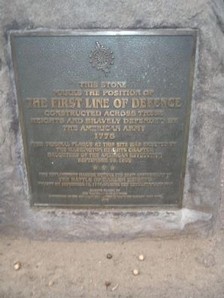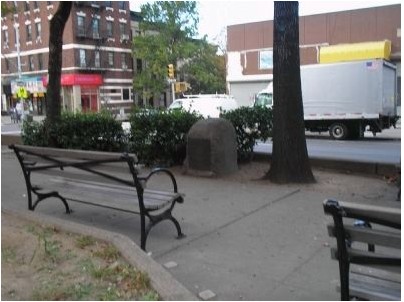“The First Line of Defence” – 1776
Introduction
Text-to-speech Audio
Images
This unfinished c. 1776 map, in the collections of the Library of Congress, shows fortifications and redoubts in New York. Although not labeled, the map includes fortifications built in the time preceding the Battle of Harlem Heights. Library of Congress call number G3804.N4:2M3S3 1776 .N4

The First Line of Defence Marker

"The Americans formed a defensive line across Broadway at this point. The photo looks south, in the direction from which the British troops approached"

Backstory and Context
Text-to-speech Audio
The Continental Army, led by Commander in Chief George Washington, was positioned along the Harlem Ridge in three lines of defense. The first line of defense was included three small redoubts, enclosed fortifications constructed to defend against an attack from any direction. The colonists "first line of defense" was roughly located at the modern day 147th Street.
Although hastily constructed, this line of defense was the most elaborate of all the defensive lines built near this site built by reserves under General Spencer. This defensive line was constructed leading up to the Battle of Harlem Heights which occurred on September 15, 1776. The works extended from St. Nicholas Avenue (then the King’s Highway) to the summit of “Break Neck Hill”, then crossed west to the old Pinehurst mansion, zigzagging irregularly afterward to the point at Broadway and 147th, finally terminating in the Hudson River. The defensive line saw action on October 27, 1776 when the Americans successfully resisted a British advance. Colonel Robert Magaw led the battle from Fort Washington.
During the final assault on Fort Washington on November 16, 1776 a much stronger attack was made on the first line of defense by the combined forces of some 4,000 British and Hessian troops led by Lieutenant General Earl Percy. The position was defended by a mere 600 Pennsylvanians and Connecticut Rangers. They made their stand until they could no longer maintain the position, retreating to Fort Washington and later surrendering to some 14,000 opponents. Most of these men were taken to prison houses and ships following their surrender and many would die in their captivity.
This structure was an important part of the defense of New York during the Revolutionary War. The Battle of Harlem Heights is often referenced by historians as a psychologically important, if small, victory for the Continental Army. After demoralizing defeats in New York, this short battle revealed to the troops that they had another option than simply, retreat.
For more information about the Battle of Harlem Heights, reference this Clio post.
For more information about the Battle of Fort Washington, reference this Clio Post
Sources
- Coughlin, Bill . The First Line of Defence, THE HISTORICAL MARKER DATABASE (HMdb.org). October 19th 2008. Accessed December 30th 2019. https://www.hmdb.org/m.asp?m=12667.
- Schenawolf, Harry . Battle of Harlem Heights Sept. 16, 1776: Americans Gave the British a Good Drubbing, Revolutionary War Journal. January 15th 2014. Accessed December 30th 2019. http://www.revolutionarywarjournal.com/battle-of-harlem-heights/.
- A List of Fortification Terminology, American Battlefield Trust. Accessed December 30th 2019. https://www.battlefields.org/learn/articles/glossary-fortification-terms.
- Stockwell, Mary . Battle of Harlem Heights, George Washington's Mt. Vernon. Accessed December 30th 2019. https://www.mountvernon.org/library/digitalhistory/digital-encyclopedia/article/battle-of-harlem-heights/.
- Daughters of the American Revolution. Washington Heights Chapter. Report of the National Society of the Daughters of the American Revolution. April 30th 1910. 109 - 110.
- "Harlem Heights Battle Revisited: Americans Briefly Turned Tide." The New York Times (New York) September 19th 1976. .48.
Library of Congress Geography and Map Division Washington, D.C. 20540-4650 USA dcu, https://www.loc.gov/resource/g3804n.ar115800/?r=-0.897,-0.086,2.793,1.685,0
By Bill Coughlin, October 19, 2008
By Bill Coughlin, October 19, 2008
